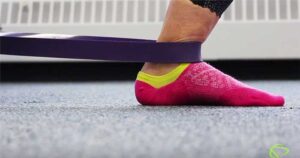In the dynamic realm of sports science, the intricate interplay between human performance and movement stands as a focal point of extensive research. Among the myriad skills crucial to various sports, the vertical jump has been a subject of thorough investigation, revealing the nuanced contributions of joint muscles. A particularly compelling revelation emerges regarding the often-underestimated role of ankle mobility, a factor that plays a pivotal role in optimizing athletic abilities.
While past studies delved into the dominance of knee and hip muscles in vertical jumps, the importance of ankle joint muscles, specifically dorsiflexion, has been insufficiently explored. Ankle mobility deficits, frequently overlooked, can significantly impact high-performance athletes, leading to an increased susceptibility to knee injuries, Achilles tendinitis, and plantar fasciitis due to reduced ankle dorsiflexion.
Ankle mobility deficiency initiates biomechanical changes, including reduced knee movement flexibility, dynamic valgus displacement, and heightened ground reaction force. These alterations compromise joint function and escalate the risk of injuries, particularly in athletes performing at the highest levels. Notably, a diminished ankle dorsiflexion angle has been linked to a higher projection of the knee, a recognized risk factor for anterior cruciate ligament (ACL) injuries.
Research indicates that reduced ankle mobility adversely affects adjacent joints, setting off a biomechanical chain reaction. Ankle mobility deficiency has been identified as negatively impacting the knee, hip, and spine joints, emphasizing the interconnectedness of the musculoskeletal system.
To further explore the correlation between ankle mobility and performance, a comprehensive study was conducted on twenty-one Under-17 soccer athletes. Utilizing knee-to-wall tests, goniometry, and countermovement jump (CMJ) assessments, researchers aimed to identify ankle mobility deficits and their potential correlation with diminished performance.
The results brought to light a significant correlation between reduced ankle mobility, particularly in dorsiflexion, and impaired jump performance. Athletes with restricted ankle mobility demonstrated notably lower CMJ heights. The study also highlighted the asymmetry in ankle mobility between the right and left limbs, underscoring the critical importance of balanced joint function.
Understanding the profound impact of ankle mobility on athletic performance opens up avenues for targeted interventions. Strategies designed to enhance ankle mobility, such as stretching and innovative techniques like Band Flossing, could prove instrumental in optimizing jump performance and preventing injuries.
This study underscores the often overlooked and underestimated role of ankle mobility in athletic performance. The established correlation between reduced ankle mobility and compromised jump performance emphasizes the imperative need for tailored interventions to unlock the full potential of athletes. As sports science continues its evolution, addressing ankle mobility could prove to be a game-changer, enhancing athletic capabilities and concurrently reducing the risk of injuries.




